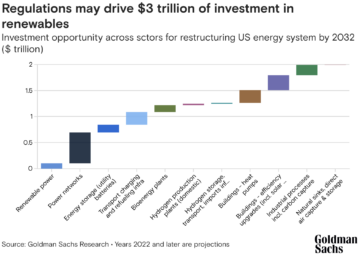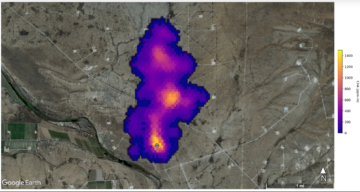This article is sponsored by the Innovation Center for U.S. Dairy.
Our food system is fragile. If ever a time made this clear, it was the spring of 2020 as the coronavirus pandemic disrupted the food supply chain in the United States and around the world. Manufacturing and food production lines came to a sudden halt, grocery store shelves were emptied and school feeding programs vanished overnight. We experienced a devastating preview of what the future of widespread food insecurity could look like.

With the experience of 2020 still fresh in our minds, and the pressing realities of a growing global population, it’s clear we need to take a more thoughtful approach to building resilient food systems. As we do, it won’t be enough to simply produce more food with less environmental impact, as some would advocate. We also need to factor in the nutritional ROI of the food we produce. Essentially, for our inputs of time, labor, land, water and energy, how much nutrition are we yielding? And how cost-effective is it to provide?
Of all foods and food groups, dairy is an especially appropriate solution to this challenge. When people consider dairy, they often immediately think of calcium and bone health, but dairy is far more of a workhorse in terms of its total nutritional package, with nutrients from high-quality protein to vitamin B12.
Not only do dairy foods provide many essential nutrients important for health, but the way these nutrients interact offers benefits too. Emerging research indicates it may be the unique matrix or interplay between nutrients, bioactive components and physical structure (liquid, solid, gel, etc.) of various dairy foods that explain health outcomes such as the reduced risk of cardiovascular disease, type 2 diabetes and hypertension.
As we consider the challenge of nourishing a growing world, dairy’s distinctive nutritional impact on the first 1,000 days of life should also be considered. That window of time in a child’s life is a crucial opportunity for nourishing brain development and health. Dairy foods provide half of the 14 nutrients the American Academy of Pediatrics identifies as essential for early brain development: protein, zinc, choline, selenium, B12, iodine and vitamin A.
Affordability and accessibility are also critical factors in ensuring a resilient and equitable food system. Dollar for dollar, milk is one of the most affordable — and easily accessible — sources of both high-quality protein and under-consumed nutrients such as calcium, vitamin D and potassium. The nutrition density of dairy makes it an essential piece of the puzzle in terms of bridging the nutritional gap that exists for many children and adults today.
And yet, dairy’s ability to play a central role in sustainable food systems is only as good as the industry’s commitment to be part of the larger climate and environmental solution. The good news is that dairy farmers in the U.S. are in many ways at the forefront of agriculture in terms of adopting innovative techniques and practices to reduce environmental impact — whether it’s nutrition modifications in cow feed that address enteric methane or milk pre-cooling technology for greater energy efficiency.
Innovation abounds on the 28,000 U.S. dairy farms today. Many dairy farms are upcycling byproducts from food that’s indigestible by humans but nutritious for cows — think almond hulls, soybean meal or other products that would otherwise end up in a landfill — and turning it to cow feed. Others are partnering with energy companies to turn cow manure into biogas that powers their local communities.
Here in the U.S., we need to focus with greater intensity on what it looks like to build sustainable food systems of the future, especially in a world of rising temperatures and increasingly erratic weather patterns. Dairy plays a pivotal role in achieving the future we all seek. The industry, for its part, earns its seat at the table through continued advancements that make dairy foods not only a shrewd nutritional and economic solution, but an environmentally sound option as well.
- SEO Powered Content & PR Distribution. Get Amplified Today.
- PlatoData.Network Vertical Generative Ai. Empower Yourself. Access Here.
- PlatoAiStream. Web3 Intelligence. Knowledge Amplified. Access Here.
- PlatoESG. Carbon, CleanTech, Energy, Environment, Solar, Waste Management. Access Here.
- PlatoHealth. Biotech and Clinical Trials Intelligence. Access Here.
- Source: https://www.greenbiz.com/article/more-sustainable-and-secure-food-system-dairy-has-place-table
- :has
- :is
- :not
- $UP
- 000
- 1
- 14
- 2020
- 28
- a
- ability
- Academy
- accessibility
- accessible
- achieving
- address
- Adopting
- adults
- advancements
- advocate
- affordable
- agriculture
- All
- also
- American
- an
- and
- approach
- appropriate
- ARE
- around
- article
- AS
- At
- BE
- benefits
- between
- biogas
- BONE
- both
- Brain
- bridging
- build
- Building
- but
- by
- came
- cardiovascular
- Cardiovascular Disease
- Center
- central
- chain
- challenge
- Children
- clear
- Climate
- commitment
- Communities
- Companies
- components
- Consider
- considered
- continued
- Coronavirus
- Coronavirus pandemic
- cost-effective
- could
- critical
- crucial
- dairy
- Days
- density
- devastating
- Development
- Diabetes
- Disease
- distinctive
- do
- Dollar
- Early
- easily
- Economic
- efficiency
- emerging
- Emerging research
- end
- energy
- energy efficiency
- enough
- ensuring
- environmental
- environmentally
- equitable
- especially
- essential
- essentially
- etc
- EVER
- exists
- experience
- experienced
- Explain
- factor
- factors
- far
- farmers
- Farms
- feeding
- First
- Focus
- food
- food supply
- food supply chain
- foods
- For
- forefront
- fresh
- from
- future
- gap
- Global
- good
- greater
- grocery
- Group’s
- Growing
- Half
- Health
- high-quality
- How
- HTTPS
- Humans
- Hypertension
- identifies
- if
- immediately
- Impact
- important
- in
- increasingly
- indicates
- industry
- industry’s
- innovative
- inputs
- insecurity
- interact
- into
- IT
- ITS
- labor
- Land
- larger
- less
- Life
- like
- lines
- Liquid
- local
- Look
- look like
- LOOKS
- made
- make
- MAKES
- manufacturing
- many
- Matrix
- May..
- methane
- Milk
- minds
- Modifications
- more
- most
- much
- Need
- news
- nutrition
- nutritional
- of
- Offers
- often
- on
- ONE
- only
- Opportunity
- Option
- or
- Other
- Others
- otherwise
- our
- outcomes
- overnight
- package
- pandemic
- part
- partnering
- patterns
- People
- physical
- piece
- pivotal
- Place
- plato
- Plato Data Intelligence
- PlatoData
- Play
- plays
- population
- powers
- practices
- pressing
- Preview
- produce
- Production
- Products
- Programs
- Protein
- provide
- puzzle
- quote
- realities
- reduce
- Reduced
- research
- resilient
- rising
- Risk
- ROI
- Role
- s
- School
- secure
- Seek
- shelves
- should
- shrewd
- simply
- solid
- solution
- some
- Sound
- Sources
- Sponsored
- spring
- States
- Still
- store
- structure
- such
- sudden
- supply
- supply chain
- sustainable
- system
- Systems
- table
- Take
- techniques
- Technology
- terms
- that
- The
- The Future
- the world
- their
- These
- they
- Think
- this
- Through
- time
- to
- today
- too
- Total
- TURN
- Turning
- type
- Type 2 diabetes
- u.s.
- unique
- United
- United States
- various
- vitamin
- was
- Water
- Way..
- ways
- we
- Weather
- weather patterns
- WELL
- were
- What
- when
- whether
- widespread
- window
- with
- world
- would
- yet
- yielding
- zephyrnet










